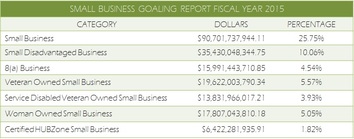| | The Federal marketplace can seem intimidating and often impenetrable for small businesses. Therefore, learning about, and taking advantage of small business opportunities can provide the competitive advantage your company is looking for. When it comes to federal contracting, small business goals help to ensure that small businesses get their fair share of contracts and access to the market. |
 Goaling Report FY2015 Data from FPDS
Goaling Report FY2015 Data from FPDS Currently, the government-wide small business goals are:
- 23% of prime contracts for small businesses;
- 5% of prime and subcontracts for women-owned small businesses (WOSB);
- 5% of prime contracts and subcontracts for Small Disadvantaged Businesses (SDB);
- 3% of prime contracts and subcontracts for HUBZone small businesses;
- 3% of prime and subcontracts for service-disabled veteran-owned small businesses (SDVOSB)
In order to achieve these government-wide goals, each agency is required to establish individual small business goals. Legislation states that “the head of each Federal agency shall, after consultation with the Administration, establish goals.” Prior to each fiscal year, SBA will negotiate with each agency to establish agency specific goals to ensure the government-wide minimum. Following the negotiation process, each agency will submit their established goals for approval by SBA. All individual agency goals are then reviewed by SBA’s Office of Government Contacting to determine whether or not their goals, in aggregate, meet or exceed the government-wide standards listed above. Once SBA approves, each agency is notified of their specific goals for the fiscal year. For more information about small-business goals and how they are established, you can visit SBA’s website at: https://www.sba.gov/contracting/contracting-officials/goaling.
In addition, monitoring agency goals should be a part of every small business’ market research strategy. Being cognizant of agency goals (prime and subcontracting) and how much they award to small businesses can be a useful tool when determining your internal marketing and business development strategy. To view the individual agency goals for Fiscal Year 2016, including prime and subcontracting goals, click on the link here: https://www.sba.gov/sites/default/files/FY2016_Final_Agency_Goals_Spreadsheet_20160404.pdf.
Furthermore, the SBA releases an annual Small Business Goaling Report, depicting the government's achievement in small business procurement. The report is produced by the the Federal Procurement Data System - Next Generation (FPDS-NG) and depicts small business awards (categorized by small business subsets, dollar amount and percentage) by each individual agency. To view the Small Business Goaling Report for Fiscal Year 2015, click on the link provided here: https://www.fpds.gov/downloads/top_requests/FPDSNG_SB_Goaling_FY_2015.pdf.
Small business goals, whether they are agency goals or prime/subcontracting goals, can provide leverage and a competitive advantage for small businesses. These goals create an inherent incentive for agencies and large primes to work with small businesses and help to increase the marketability of your small business.
For more information on this or other issues relevant to small businesses in Federal contracting, please contact us at: info@holomuaconsulting.com.




